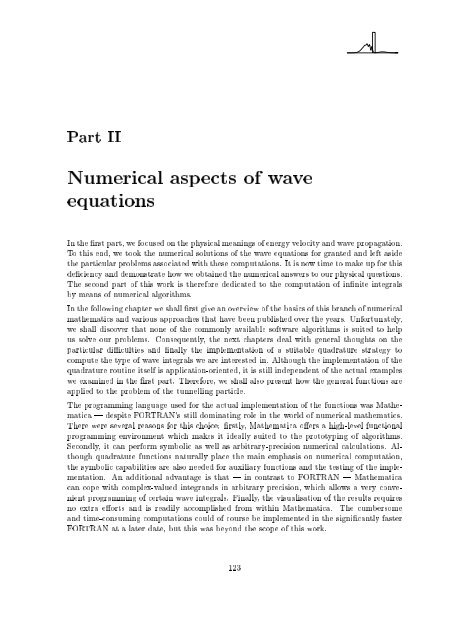Wave Propagation in Linear Media | re-examined
Wave Propagation in Linear Media | re-examined
Wave Propagation in Linear Media | re-examined
You also want an ePaper? Increase the reach of your titles
YUMPU automatically turns print PDFs into web optimized ePapers that Google loves.
Part II<br />
Numerical aspects of wave<br />
equations<br />
In the rst part, we focused on the physical mean<strong>in</strong>gs of energy velocity and wave propagation.<br />
To this end, we took the numerical solutions of the wave equations for granted and left aside<br />
the particular problems associated with these computations. It is now time to make up for this<br />
de ciency and demonstrate how we obta<strong>in</strong>ed the numerical answers to our physical questions.<br />
The second part of this work is the<strong>re</strong>fo<strong>re</strong> dedicated to the computation of <strong>in</strong> nite <strong>in</strong>tegrals<br />
by means of numerical algorithms.<br />
In the follow<strong>in</strong>g chapter we shall rst give anoverview of the basics of this branch ofnumerical<br />
mathematics and various approaches that have been published over the years. Unfortunately,<br />
we shall discover that none of the commonly available softwa<strong>re</strong> algorithms is suited to help<br />
us solve our problems. Consequently, the next chapters deal with general thoughts on the<br />
particular di culties and nally the implementation of a suitable quadratu<strong>re</strong> strategy to<br />
compute the type of wave <strong>in</strong>tegrals we a<strong>re</strong> <strong>in</strong>te<strong>re</strong>sted <strong>in</strong>. Although the implementation of the<br />
quadratu<strong>re</strong> rout<strong>in</strong>e itself is application-oriented, it is still <strong>in</strong>dependent of the actual examples<br />
we exam<strong>in</strong>ed <strong>in</strong> the rst part. The<strong>re</strong>fo<strong>re</strong>, we shall also p<strong>re</strong>sent how the general functions a<strong>re</strong><br />
applied to the problem of the tunnell<strong>in</strong>g particle.<br />
The programm<strong>in</strong>g language used for the actual implementation of the functions was Mathematica<br />
| despite FORTRAN's still dom<strong>in</strong>at<strong>in</strong>g role <strong>in</strong> the world of numerical mathematics.<br />
The<strong>re</strong> we<strong>re</strong> several <strong>re</strong>asons for this choice: rstly, Mathematica o ers a high-level functional<br />
programm<strong>in</strong>g environment which makes it ideally suited to the prototyp<strong>in</strong>g of algorithms.<br />
Secondly, it can perform symbolic as well as arbitrary-p<strong>re</strong>cision numerical calculations. Although<br />
quadratu<strong>re</strong> functions naturally place the ma<strong>in</strong> emphasis on numerical computation,<br />
the symbolic capabilities a<strong>re</strong> also needed for auxiliary functions and the test<strong>in</strong>g of the implementation.<br />
An additional advantage is that | <strong>in</strong> contrast to FORTRAN | Mathematica<br />
can cope with complex-valued <strong>in</strong>tegrands <strong>in</strong> arbitrary p<strong>re</strong>cision, which allows a very convenient<br />
programm<strong>in</strong>g of certa<strong>in</strong> wave <strong>in</strong>tegrals. F<strong>in</strong>ally, the visualisation of the <strong>re</strong>sults <strong>re</strong>qui<strong>re</strong>s<br />
no extra e orts and is <strong>re</strong>adily accomplished from with<strong>in</strong> Mathematica. The cumbersome<br />
and time-consum<strong>in</strong>g computations could of course be implemented <strong>in</strong> the signi cantly faster<br />
FORTRAN at a later date, but this was beyond the scope of this work.<br />
123












